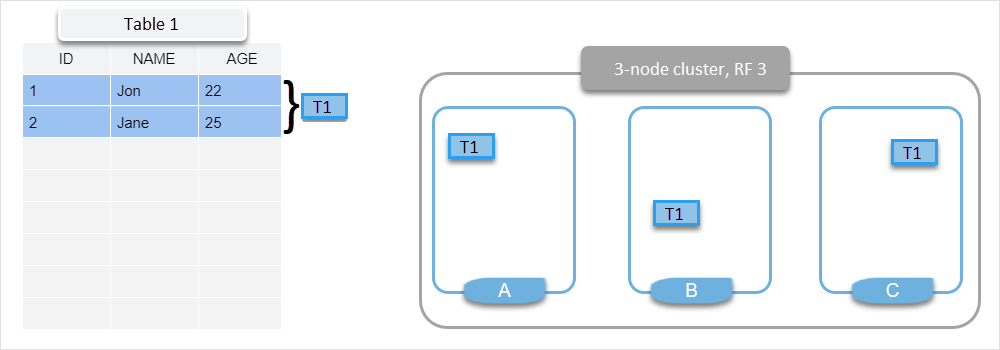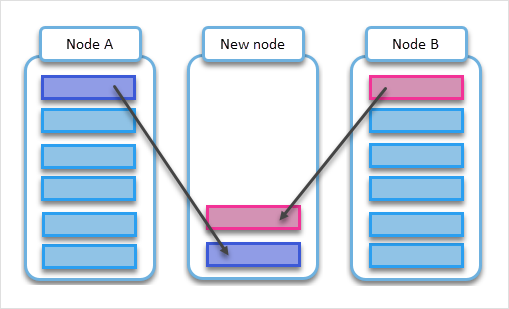Was this page helpful?
Caution
You're viewing documentation for a previous version. Switch to the latest stable version.
Data Distribution with Tablets¶
A ScyllaDB cluster is a group of interconnected nodes. The data of the entire cluster has to be distributed as evenly as possible across those nodes.
ScyllaDB is designed to ensure a balanced distribution of data by storing data in tablets. When you add or remove nodes to scale your cluster, add or remove a datacenter, or replace a node, tablets are moved between the nodes to keep the same number on each node. In addition, tablets are balanced across shards in each node.
This article explains the concept of tablets and how they let you scale your cluster quickly and seamlessly.
Data Distribution¶
ScyllaDB distributes data by splitting tables into tablets. Each tablet has its replicas on different nodes, depending on the RF (replication factor). Each partition of a table is mapped to a single tablet in a deterministic way. When you query or update the data, ScyllaDB can quickly identify the tablet that stores the relevant partition.
The following example shows a 3-node cluster with a replication factor (RF) of 3. The data is stored in a table (Table 1) with two rows. Both rows are mapped to one tablet (T1) with replicas on all three nodes.

Load Balancing¶
ScyllaDB autonomously moves tablets to balance the load. This process is managed by a load balancer mechanism and happens independently of the administrator. The tablet load balancer decides where to migrate the tablets, either within the same node to balance the shards or across the nodes to balance the global load in the cluster.
As a table grows, each tablet can split into two, creating a new tablet. The load balancer can migrate the split halves independently to different nodes or shards.
The load-balancing process takes place in the background and is performed without any service interruption.
Scaling Out¶
A tablet can be dynamically migrated to an existing node or a newly added empty node. Paired with consistent topology updates with Raft, tablets allow you to add multiple nodes simultaneously. After nodes are added to the cluster, existing nodes stream data to the new ones, and the system load eventually converges to an even distribution as the process completes.
With tablets enabled, manual cleanup is not required. Cleanup is performed automatically per tablet, making tablets-based streaming user-independent and safer.
In addition, tablet cleanup is lightweight and efficient, as it doesn’t involve rewriting SStables on the existing nodes, which makes data ownership changes faster. This dramatically reduces the impact of cleanup on the performance of user queries.
The following diagrams show migrating tablets from heavily loaded nodes A and B to a new node.

Enabling Tablets¶
ScyllaDB now uses tablets by default for data distribution. This functionality is
controlled by the enable_tablets option. However, tablets only work if
enabled on all nodes within the cluster.
When creating a new keyspace with tablets enabled (the default), you can still disable
them on a per-keyspace basis. The recommended NetworkTopologyStrategy for keyspaces
remains required when using tablets.
You can create a keyspace with tablets
disabled with the tablets = {'enabled': false} option:
CREATE KEYSPACE my_keyspace
WITH replication = {
'class': 'NetworkTopologyStrategy',
'replication_factor': 3
} AND tablets = {
'enabled': false
};
Warning
You cannot ALTER a keyspace to enable or disable tablets.
The only way to update the tablet support for a keyspace is to DROP it
(losing the schema and data) and then recreate it after redefining
the keyspace schema with tablets = { 'enabled': false } or
tablets = { 'enabled': true }.
Limitations and Unsupported Features¶
The following ScyllaDB features are not supported if a keyspace has tablets enabled:
Counters
Change Data Capture (CDC)
Lightweight Transactions (LWT)
Alternator (as it uses LWT)
If you plan to use any of the above features, CREATE your keyspace with tablets disabled.
Resharding in keyspaces with tablets enabled has the following limitations:
ScyllaDB does not support reducing the number of shards after node restart.
ScyllaDB does not reshard data on node restart. Tablet replicas remain allocated to the old shards on restart and are subject to background load-balancing to additional shards after restart completes and the node starts serving CQL.
